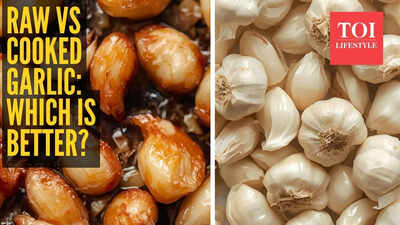ARTICLE AD BOX

Garlic has been revered for centuries not only as a flavorful ingredient in cooking but also for its medicinal properties. The question that often arises is whether raw garlic or cooked garlic offers greater health benefits.
Scientific studies show that both forms of garlic have valuable health effects, but they differ in their bioactive compound profiles, potency, and how they influence the body. Understanding these differences can help you optimize consumption for maximum health benefits.
Why raw garlic?
Raw garlic contains the highest concentration of allicin, a powerful sulfur-containing compound formed when garlic is crushed or chopped.
Allicin is responsible for much of garlic’s antimicrobial, antioxidant, and anti-inflammatory properties. Clinical and observational studies on raw garlic consumption reveal benefits such as improved lipid profiles, reduced blood pressure, enhanced immune function, and a lower risk of some cancers.
For example, raw garlic intake has been linked to a reduced risk of liver, esophageal, and lung cancers, as well as improvements in metabolic and cardiovascular parameters.
The fresh, raw form delivers the most potent therapeutic effects, particularly for cardiovascular health and immune support.[1][2]
Why cook garlic? Is it better?
Cooking garlic reduces the amount of allicin because this compound is heat-sensitive and degrades under high temperatures. However, cooked garlic is still rich in other sulfur compounds that have antioxidant and anti-inflammatory effects. Cooking may also increase the bioavailability of some nutrients, making it easier to consume in larger amounts without the sharp pungency of raw garlic.
Studies have shown that cooked garlic still improves blood sugar control, memory, and oxidative stress, retaining significant health benefits even if the raw form is more potent in some regards.
Which is better: Raw vs. Cooked Garlic
The answer depends on the health goals and personal tolerance of the individual. Raw garlic provides stronger antimicrobial and cardiovascular benefits due to allicin, but its pungency and strong flavor may be off-putting to some and can cause digestive discomfort if consumed excessively.
Cooked garlic offers a milder taste, retains antioxidant properties, and can be easier to incorporate into daily meals. A balanced approach that includes both raw and cooked garlic is often recommended to harness the full spectrum of health benefits.
How to boost efficacy of garlic?
To maximize allicin formation and health effects, crush or chop raw garlic and let it sit for about 10 minutes before consuming or cooking. This rest time allows the enzymatic conversion of alliin to allicin.
Using raw garlic in salad dressings, dips, or finishing dishes preserves its potency. Cooking garlic gently or roasting it slowly helps retain some beneficial compounds while easing flavor intensity. Garlic supplements, such as aged garlic extract, offer alternative benefits, especially for cardiovascular health, but fresh garlic remains the most natural and potent source.
How allicin in garlic reacts?
Raw garlic contains significantly higher levels of allicin compared to cooked garlic.
Allicin is formed when garlic cloves are crushed or chopped, enabling the enzyme alliinase to convert alliin into allicin rapidly within a minute. Raw minced garlic typically contains about 2.5 to 4.5 mg of allicin per gram, resulting in approximately 10 to 18 mg of allicin per medium-sized clove.When garlic is cooked, especially by roasting or boiling, the heat inactivates the alliinase enzyme, which drastically reduces allicin formation.
As a result, roasted garlic contains much less allicin per gram—about one-third or less compared to raw garlic. To achieve the same allicin intake from cooked garlic, you would need to consume about three times more roasted garlic. While some allicin may form if garlic is crushed and allowed to rest before gentle cooking, the intense heat of cooking typically degrades much of the allicin, leading to a milder flavor and reduced allicin content.
Lastly, it can be concluded that raw garlic provides the highest allicin levels, which are responsible for many of its health benefits, whereas cooked garlic has lower allicin but still retains other beneficial compounds. Allowing crushed garlic to sit for 10 minutes before cooking can help preserve some allicin. This balance explains why raw garlic is considered more potent in delivering allicin, but cooked garlic remains a valuable healthful food.

 4 hours ago
5
4 hours ago
5









 English (US) ·
English (US) ·